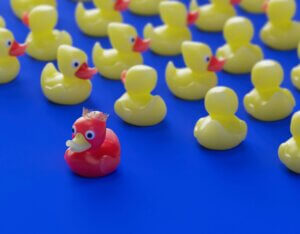To command a premium as AI democratises agency capabilities, CEOs must rethink their traditional approach to standing out.

Agencies have long settled for superficial distinctiveness over deep differentiation. Generic offers of ‘great work for ambitious brands’ are everywhere. As are variations on ‘inserting brands into culture’ or giving clients ‘an unfair share of attention’.
Without a compelling reason for clients to choose you, you’re just another option in an ever deeper sea of sameness. No wonder traditional repositioning exercises so frequently fail to create lasting change in commercial performance.
Now AI is upping the ante on differentiation. The pace at which capabilities are being democratised is remarkable. And once everyone has access to similar tools, it will get even harder for your agency to stand out – let alone command a premium.
That’s why agencies need a new model of differentiation – one rooted in clarity, conviction and relevance. We call this creating a ‘Market of One’.
What is a Market of One?
Being in a Market of One means becoming the obvious choice for certain clients when they’re facing a certain challenge.
This could be literally anything – narrow or broad – from supercharging iconic brands to helping start-ups secure funding. You become the obvious choice when what you offer is unique.
As your competitors increasingly offer the same capabilities, applying your experience, culture and beliefs can make your agency tangibly different for the clients that matter.
You become the leader in a category defined by your own expertise. This gives you a clear and lasting competitive advantage.
Differentiation is business strategy
Creating your Market of One runs much deeper than external packaging. This isn’t about fancy copywriting.
Instead, it’s about single-minded focus – total clarity of business strategy alongside relentless execution to make it real. You need deep conviction about who you are and the specific client challenges that you’re best placed to solve.
If you’ve spent years striving for ‘uniqueness’, perhaps all this sounds idealistic. But creating a Market of One is actually based on well-established thinking – albeit thinking that agencies rarely apply.
In his 1980 book, Competitive Strategy, revered author and Harvard Business School professor Michael Porter described how companies can differentiate themselves on what their customers value, or by focusing on selected market segments.
Creating a Market of One combines these ideas and then extends them – defining ‘segment’ in broader, more behavioural terms than traditional verticals.
Another valuable reference point is the ‘resource-based view’ (RBV) of company attributes, as popularised by Jay Barney’s 1991 article, Firm Resources and Sustained Competitive Advantage.
This is about utilising the capabilities, competencies and assets most likely to deliver a competitive edge, using the so-called ‘VRIN’ model:
- Valuable: Solving specific problems
- Rare: Bringing unique perspectives and experience
- Inimitable: Building on authentic beliefs
- Non-substitutable: Delivering outcomes that others can’t.
By combining focused differentiation, a discrete target audience and the application of your unique qualities, you can create your Market of One.
Tangible competitive advantage
Ultimately, you’re cultivating ownability – like Coca-Cola owns ‘happiness’ or Kit-Kat owns the idea of ‘having a break’. But remember this isn’t consumer branding. It’s not about fancy straplines and repetition powered by vast media budgets.
Agency differentiation demands more than distinctiveness and consistency. Cutting through the noise requires a clear, tangible offer that your ideal clients can quickly understand – and value.
So whether you want to accelerate from good to great, or turn around poor performance, developing your Market of One is an act of commercial transformation – and in the age of AI, an act of survival.